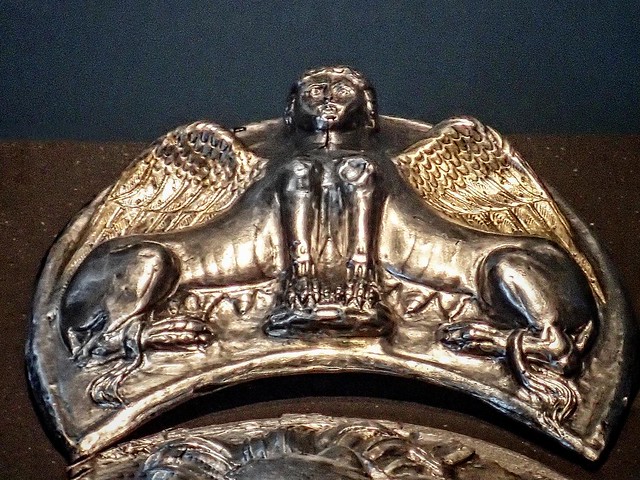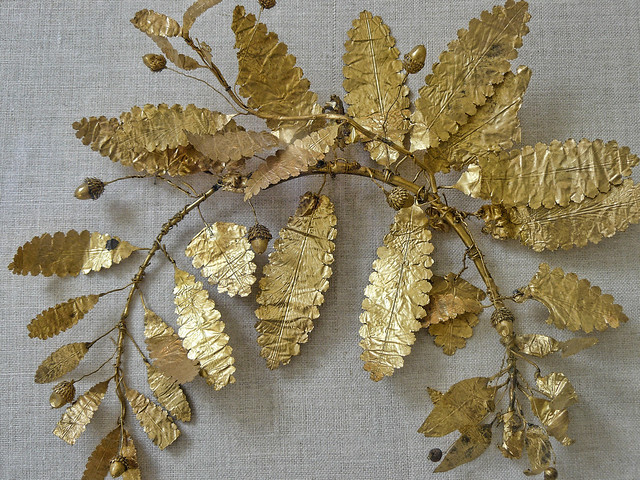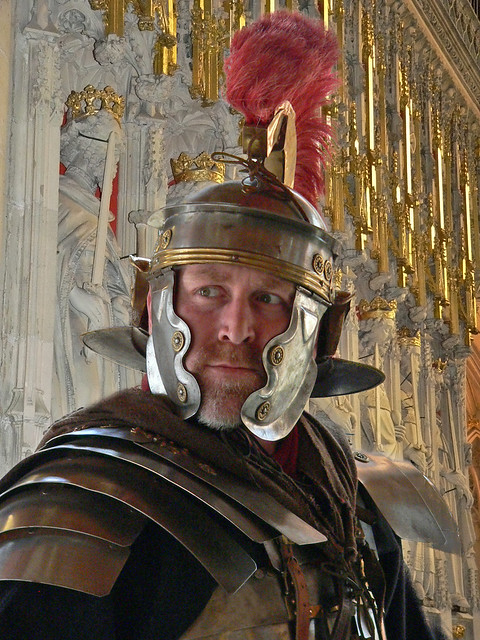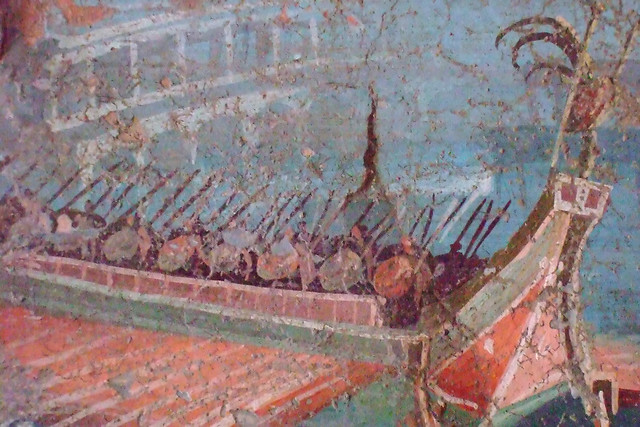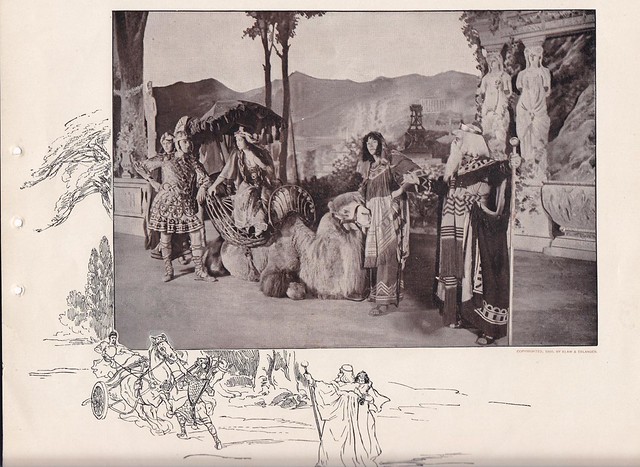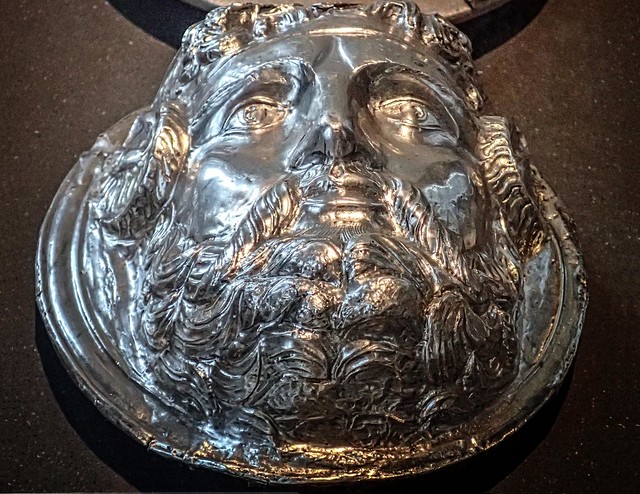 |
| One of nine Silvered bronze phalerae depicting a mythological figure (Zeus Ammon) awarded to Titus Flavius Festus Roman 1st century CE. Photographed at the Neuses Museum in Berlin, Germany by Mary Harrsch © 2016 |
A history resource article by Mary Harrsch © 2016
A few months ago I visited the Neues Museum in Berlin, Germany. I was with an ancient Egypt study group so, of course, the bust of Nefertiti along with the large collection of artifacts from the Amarna region was our main purpose for going there. However, being an ancient Roman history enthusiast, I gravitated towards the museum's Roman collection and was excited to find a set of Roman phalerae belonging to Titus Flavius Festus found near Lauresfort, Germany a few miles south of the site of the large Roman fortress of Castra Vetera.
Castra Vetera was founded by the Roman commander Drusus, a stepson of emperor Augustus and brother to the future emperor Tiberius, on the hill now known as Fürstenberg, about sixty Roman miles below the capital of Germania Inferior, Colonia Claudia Ara Agrippinensium (modern Cologne). Vetera controlled the confluence of the rivers Rhine and Lippe. Drusus used Castra Vetera as one of his bases when he invaded the east bank of the Rhine.
Archaeologists aren't sure which legions were stationed there but a cenotaph of Marcus Caelius found there mentions the Eighteenth Legion that was annihilated in the battle of the Teutoburg Forest in September of 9 CE. After the battle, Tiberius ordered fortifications made of wood to accommodate two legions, V Alaudae and XXI Rapax. Both units took part in the Germanic campaigns of Germanicus in the first years of the reign of Tiberius (14-16 CE) and the unsuccessful campaign against the Frisians of 28 CE. After 43 CE, XXI Rapax was replaced by XV Primigenia. In 69-70 CE (Yes, that fateful year of the four emperors!) Castra Vetera was razed to the ground during the Batavian revolt and all of the soldiers who defended the fort were murdered after they surrendered.
The depictions of mythological figures and a lion's head, though, do look very similar to the depictions of phalerae shown on the cenotaph of Marcus Caelius, who appears to have served in the 18th Legion. If so, perhaps Titus Flavius Festus served in the 18th as well and buried his precious dona before leaving on that fateful march through the Teutoburg Forest.
 |
| Cenotaph of Marcus Caelius, centurion of the 18th Legion. Image courtesy of Jona Lendering |
 |
| Chalcedony phalera from the Perm Urals. Image courtesy of Alexander Kolobov, Andrej Melnitchuk and Nadeshda Kulyabina |
The best reference I found was "The Military Decorations of the Roman Army" by Valerie A. Maxfield of the University of Exeter published in 1981. Fortunately for me, although the hard copy can still be purchased up on Amazon it is rather expensive, I found the volume in its entirety up on Google Books.
In it, Maxfield explains, "The first recorded example of Roman military decoration dates to the very early years of the Republic, to the middle of the fifth century BC [although we'll see that she doubts the accuracy of this reference]. At the other end of the scale, award-giving on a regular basis came to an end in the early third century AD, though sporadic examples do occur to the very end of the Roman Empire in the West and into the Byzantine era." - Valerie A. Maxfield, The Military Decorations of the Roman Army
In his review of Maxfield's book, Professor Lawrence Keppie explains further, "The award of dona militaria can be traced back to the very beginnings of the Roman state. Evidence from the Republic is slight, in the absence of a substantial epigraphic record, but we should not necessarily be led to suppose that no hierarchy of award had yet been devised. Certainly, by the late first century A.D., a system as complex as that used by any modern army was in being. Awards were related to military rank rather than degree of heroism. Ordinary soldiers were given sets of torques (necklets), armillae (bracelets) and phalerae (medallions); evocati and centurions might receive the same, plus a corona aurea (golden crown); equestrian and senatorial officers were given sets of coronae, hastae purae (spears, perhaps silver-tipped), and vexilla (standards), according to their rank. Much less is known about the corniculum (little horn?) and phiale (dish), which do not seem to have continued in use into the Empire."
"Such a professional standing army required a career structure with incentives to the potential recruit, the prospects of advancement in rank and status, and the security which came from adequate regular pay, good conditions of service and a gratuity on discharge sufficient to ease the transition back into civilian life. Likewise, the expansion of Rome's military commitments led to a steady proliferation of permanent regular units requiring to be officered. This, together with the acquisition of overseas territories to be governed, necessitated changes in the structure and organization of command at its higher levels." - Valerie A. Maxfield, The Military Decorations of the Roman Army
Maxfield bemoans the paucity of evidence relating to the award of decorations. She divides most of the evidence available into three categories: literary sources, inscriptions on stone (and occasionally on metal) and sculpture, acknowledging that archaeological evidence of the decorations themselves is patchy at best.
Surprisingly, most literary evidence is found in Republican Period sources.
"Doubtless there existed in the Roman period a written code of practice relating to the presentation of awards for gallantry; such a code would be necessary for the efficient and equitable running of the system, but none such has survived, nor any of the rolls of honour which must have been maintained at Rome, nor the soldiers' individual files which would have recorded all details of their military career including any distinctions gained in the field...Many of the conclusions which will be put forward about the development and functioning of the system of military reward are based on negative rather than on positive evidence and must therefore be regarded as far from definitive - no more than one way of interpreting the [extremely limited] material available." - Valerie A. Maxfield, The Military Decorations of the Roman Army
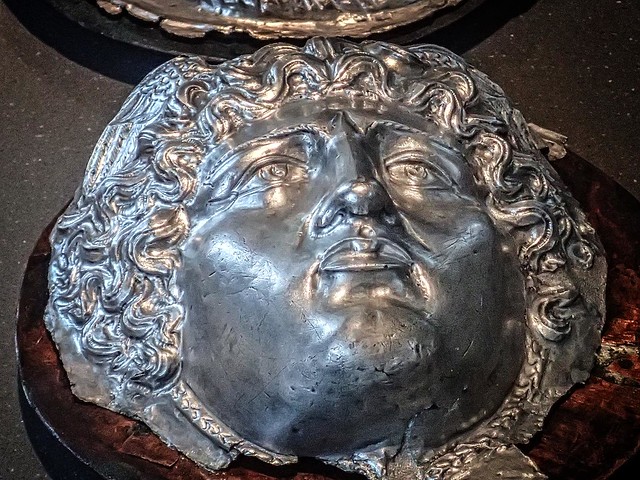 |
| The Gorgon, Medusa, was popular imagery because of the legionaries' beliefs in its protective properties. Photographed at the Neues Museum by Mary Harrsch © 2016 |
"All the sources are in broad agreement over the detail of his military awards and yet the list is out of place in a fifth-century context. It is, for example, highly doubtful whether specific crowns for saving the lives of Roman citizens and for being the first to scale an enemy wall had developed as early as this. The whole thing is suspiciously anachronistic..." - Valerie A. Maxfield, The Military Decorations of the Roman Army
If Maxfield is correct, perhaps the inclusion of phalerae in the list of awards is also anachronistic and the award form may have been adopted after intensive contact with the Celts during Hannibal's invasion and/or Caesar's later Gallic Wars after all.
 |
| Although this phalera may depict Juno or Minerva, it may be a portrait of Agrippina, wife of the popular Roman commander Germanicus. Photographed at the Neues Museum by Mary Harrsch © 2016 |
Then she addresses the problem of epigraphic evidence concentrating on centurions and officers. Of the inscriptions found, she points out that most come from the first and second centuries CE.
"Although the practice of setting up inscriptions to honour the dead or the living was one which spread over almost the whole social scale, the quality and quantity of information given are heavily weighted towards the top end of the economic and social ladder. The reason for this is readily apparent. The cutting of monumental inscriptions was a skilled job and the stonemason would have charged accordingly; the more competent the mason the higher the fee he could command, the longer and more verbose the text the greater the cost. A legionary centurion of the Principate earned more than sixteen times as much as did a common soldier, a camp prefect two-and-a-half times as much again. An equestrian officer at the height of his military career had a salary comparable to that of the camp prefect but only half that which a decenarian procurator could command." - Valerie A. Maxfield, The Military Decorations of the Roman Army
Like Maxfield, I launched into a search for references to decorations on Roman military tombstones. The easiest to find were often stones with images of decorations and military equipment, sometimes without any inscription at all. Maxfield says sometimes a reference could be as subtle as just the letters "d.d." for "donis donatus" meaning "having been decorated." Another problem she points out is the wealthy, who may have had multiple monuments erected to them, may not have mentioned the details of military service but include only a general summary like two of three monuments honoring P. Cominius Clemens found in the cities of Concordia and Aquileia. His illustrious equestrian career in which he commanded three auxiliary units and was decorated during the second of these commands is merely summarized as "omnibus equestribus militiis functo" ("having served at all the equestrian military levels.")
"While the relatively poor might not be able to afford to record the career in full, the richer and more powerful who have attained positions of honour and influence might not deem it worthwhile to specify the lower posts held.." - Valerie A. Maxfield, The Military Decorations of the Roman Army
Sculptural evidence is similarly concentrated with most dated to the Augustan period. She attributes this to the generous donatives given by the emperor to his troops after the upheavals of the Civil War.
So, how many were actually awarded?
In a study of 70 Roman military funerary monuments, Professor Lawrence Keppie found only one depicting dona militaria.
Maxfield explains, "The surviving evidence for the officers and men of the Roman army is so partial that it will never be possible to work out a reliable figure for the proportion of serving soldiers who received military decorations. One thing which is certain, however, is that dona militaria never became campaign medals simply designed to acknowledge the active participation of a soldier in a given campaign: the individual who wished to receive a decoration of any sort had to fight harder, better and more successfully than those around him." - Valerie A. Maxfield, The Military Decorations of the Roman Army
Maxfield does include an analysis of a couple of lists of soldiers from particular units, though. The first list was comprised of names of men recruited to the praetorian guard between 153 and 156 CE then discharged between 169 and 172 CE. They may have accompanied Verus on his Parthian campaign (162-166 CE) and Marcus Aurelius and Verus on the early part of the German war of 166-175 CE. Although the list is incomplete, of sixty-nine men, nine (13% had the d.d. designation). She points out that this percentage is considerably higher than indicated on records of Legio VII Claudia stationed near Viminacium in Moesia Superior at about the same time. In a list of 195 of their names, Maxfield found only ten (less than 7%) were designated d.d.
This may not be as atypical as Maxfield thinks, however. Men who distinguished themselves in the legions were often recruited for the praetorian guard so the caliber of individual soldier in the praetorian guard was already a step above field recruits. We also don't know if the d.d. designation represented awards given after their induction into the praetorian guard or at some other point in their career. There would also be the "exposure to the illustrious" factor. As the emperor's chosen corps, they would be under more scrutiny by the emperor in the field, so valorous actions would probably be more quickly observed and documented by the emperor's staff than similar actions in other units.
 |
| One of the Lauersfort phalerae depicting a lion head. Photographed at the Neues Museum by Mary Harrsch © 2016 |
Polybius described the qualities required of a centurion: 'they do not desire them so much to be men who will initiate attacks and open the battle, but men who will hold their ground when worsted and hard-pressed and be ready to die at their posts.'
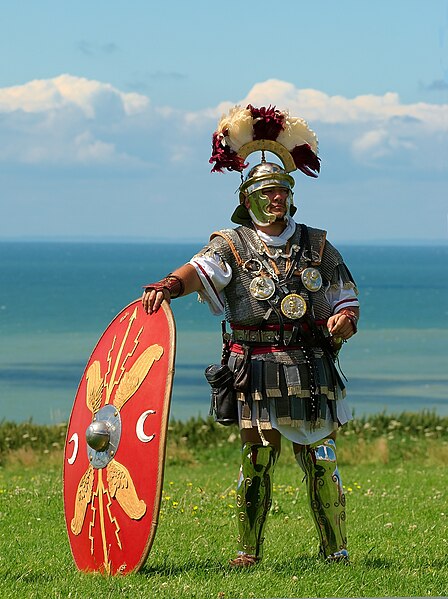 |
| Roman reenactor dressed as a centurion. Photo by Luc Viator courtesy of Wikimedia Commons. |
Julius Caesar noted that in a battle against the Nervii in 57 BCE, 'all the centurions of the fourth cohort had been slain and a standard-bearer likewise...almost all the centurions of the other cohorts were wounded or killed, among them the chief centurion, P. Sextius Aculus, bravest of men, who was overcome by many grievous wounds so that he could no longer hold himself upright.'
So what happened to the dona militaria of those killed in action? Were their decorations sent to their families? Maxfield thinks not.
"On the death of the soldier who won them, they may well have been returned or sold back to his unit (this was a common practice with standard military equipment) and later re-used..." - Valerie A. Maxfield, The Military Decorations of the Roman Army
What other activities could have also resulted in the loss of dona militaria?
"A passage from the Histories of Tacitus points to what may well have been the ultimate fate of large numbers of decorations in times of financial crisis. Tacitus tells us how some of the supporters of Vitellius at Cologne in AD 69, not having money to give to help finance the war, were urged to part with their valuables including their phalerae...Another allusion to the melting down of military decorations appears in the pages of the Elder Pliny: 'if only Fabricius who forbade gallant generals to possess more than a dish and a salt-cellar of silver would see how nowadays the rewards of valour are made from the utensils of luxury or else are broken up to make them.'" - Valerie A. Maxfield, The Military Decorations of the Roman Army
 |
| Roman portrait once thought to be Vitellius. Image courtesy of Wikimedia Commons |
"...soldiers of Sulla and Caesar, who, wearing their decorations at the funerals of their one-time commanders, cast the dona on to the funeral pyres as a final tribute (App., BC I. 105; Suet., Caesa. 84.4., App., BC II.148)"
Maxfield points out that not one military crown of any type has ever been identified. She also says not a single vexillum nor a hasta pura has ever been found either, although scholar M. Rostovtzeff, in his paper "Vexillum and Victory", published in 1942 in the Journal of Roman Studies, purports to have identified at least one vexillum.
Although the most coveted crowns like the corona obsidionalis were made of perishable vegetation from the scene of the action, it seems hardly possible that not a single corona aurea has been found. I've seen so many 5th - 3rd century BCE gold Greek wreaths in museums and traveling exhibits I have lost count. But, apparently, such Roman crowns are nonexistent.
In his paper, "Having Been a Soldier: The Commemoration of Military Service on Funerary Monuments of the Early Roman Empire", Lawrence Keppie explains:
"The great majority of memorials at Este, and at least half of those from Antiochia, were not erected in cemeteries at the towns themselves, but often in what appear isolated contexts in the territorium, that is most obviously on the land plots which the colonists had obtained at the close of the military service...In many cases, the memorial would be seen principally, not by fellow colonists or any serving military men (like those erected outside a legionary fortress such as Mainz), but by family and neighbours."
Such isolated burials would be prime pickings for passing grave robbers and thieves.
In his paper, "Vexillum and Victory" published in Vol. 32 of The Journal of Roman Studies, Rostovtzeff says, "The representation on a monument of specific allusions, e.g. military standards or dona militaria, is really quite rare, and presumably restricted to those entitled to be so depicted. [However,] The dona themselves are often shown very prominently, and when painted would have been easily distinguished from afar."
I was particularly intrigued by Keppie's reference to a case in Cremona where a soldier, serving under Augustus had his dona militaria interred with his ashes. I wish Keppie had been more specific. He only footnoted a 1971 publication by Pontiroli which is pretty hard to track down without a title or the name of the journal in which it appeared. I thought, perhaps, the dona militaria may have ended up in the local archaeological museum which in the case of Cremona would be The Museo Archeologico di San Lorenzo. So, I eagerly viewed as many images of that museum's collections as I could find, including images taken by visitors uploaded to TripAdvisor, but saw no funerary monuments from the Augustan period or dona militaria, although the museum's website mentions ceramic/glass/bronze grave goods and dona militaria were often silvered bronze. I later found a reference that mentioned bronze torques being found but no mention of anything else. Based on Maxfield's discussion of how decorations were usually awarded in sets, there should have been more decorations found than just a couple of torques.
Professor Keppie also pointed out that a number of soldiers' graves were plundered by later Christians for stone to build their churches.
"...a panel showing phalerae is built into the thirteenth-century bell-tower of the Cathedral at Benevento...There are certainly numerous fragments of sculptural decoration of what must have been large monuments, most probably to primipilares, equestrian officers and even senatorial commanders." - Lawrence Keppie, 'Having been a soldier': The Commemoration of Military Service on Funerary Monuments of the early Roman Empire
Keppie says that a number of sculptured panels are also built into the church of San Domenico at Sora (Lazio), which include an eagle and military standard. I would assume that any dona militaria found containing precious metals would have been similarly confiscated and melted down especially in view of their pagan imagery.
Maxfield says one of the underlying problems is the difficulty in identifying military decorations in first place. She explains that some of the minor awards were derived from personal ornaments and there appears to be no standard design used for the dona. Bronze torques found during the excavation of the Roman fort of Benwell on Hadrian's Wall could have just as well been local native ornaments traded for Roman goods as military decorations.
"The commonest type of decoration to be found is the phalera. The problem of interpretation here arises from the fact that phalerae were used for purposes other than military award; they served for example as horse-trappings and these trappings are not always readily distinguishable from military decorations - both are ornate metal discs design to be attached to leather straps. Only in cases such as that of the Lauersfort phalerae where a complete set [of nine] was found in close proximity to a legionary fortress (Vetera bei Xanten in Lower Germany) can we be confident that we are dealing with genuine dona militaria." - Valerie A. Maxfield, The Military Decorations of the Roman Army
At least I had the opportunity to view one set! Judging from their rarity, they should be worth more than the Hope Diamond!
References:
Kolobov, A., Melnichuk, A., & Kulyabina, N. (2001). The Roman military phalera from the Perm Urals. Arheoloŝki vestnik , 52, 351-357.
Maxfield, V. A. (1981). The military decorations of the Roman army. Berkeley: Univ. of California Pr.
Keppie, L. (1982). The Journal of Roman Studies, 72, 185-186. doi:10.2307/299132
Keppie, L. (2003). 'HAVING BEEN A SOLDIER' THE COMMEMORATION OF MILITARY SERVICE ON FUNERARY MONUMENTS OF THE EARLY ROMAN EMPIRE. Bulletin of the Institute of Classical Studies. Supplement, (81), 31-53. Retrieved from http://www.jstor.org/stable/43768066
Rostovtzeff, M. (1942). Vexillum and Victory. The Journal of Roman Studies, 32, 92-106. doi:10.2307/296463
Polybius, Histories, 6.39 (military decorations)
C. Julius Caesar, Commentarii de Bello Gallico, multiples references
Tacitus, The Histories, multiple references
Appian, Bellum Civile, multiple references
Suetonius, De Vita Caesarum, multiple references
 |
 |
 |
